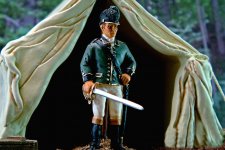PolarBear
Major
- Joined
- Feb 24, 2007
- Messages
- 6,706
British Cavalry officer Banastre Tarleton is remembered for his ruthless pursuit and treatment of the American colonials during the War of Independence. Below is a description of his most notorious moment during the war: The Buford Massacre” Randy 1/17/08
“On May 29, 1780 Tarleton, with a force of 150 mounted soldiers, overtook a detachment of 350 to 380 Virginia Continentals led by Abraham Buford. Buford refused to surrender or even to stop his march. Only after sustaining heavy casualties did Buford order the surrender. What happened next is cause of heated debate. According to American accounts, Tarleton ignored the white flag and mercilessly massacred Buford's men. By Tarleton's own account, his horse was shot from under him in the charge, and chaos erupted when his men believed he had been killed. In the end, 113 Americans were killed and another 203 captured, 150 of whom were so badly wounded that they had to be left behind. Tarleton's casualties were 5 killed and 12 wounded [1]. The British called the affair the Battle of Waxhaw Creek, while the Americans knew it as the Buford Massacre or the Waxhaw Massacre.
In recounting Tarleton's action at the scene one member of the British Army who was there, a surgeon named Robert Brownfield, wrote that "... Tarleton with his cruel myrmidons was in the midst of them, when commenced a scene of indiscriminate carnage, never surpassed by the ruthless atrocities of the barbarous savages." The Waxhaw massacre became an important rallying cry for the revolutionaries. Many people who had been more or less neutral became ardent supporters of the Revolution after the perceived atrocities. "Tarleton's quarter" and "no quarter" became rallying cries for American Patriots for the rest of the war.”
“On May 29, 1780 Tarleton, with a force of 150 mounted soldiers, overtook a detachment of 350 to 380 Virginia Continentals led by Abraham Buford. Buford refused to surrender or even to stop his march. Only after sustaining heavy casualties did Buford order the surrender. What happened next is cause of heated debate. According to American accounts, Tarleton ignored the white flag and mercilessly massacred Buford's men. By Tarleton's own account, his horse was shot from under him in the charge, and chaos erupted when his men believed he had been killed. In the end, 113 Americans were killed and another 203 captured, 150 of whom were so badly wounded that they had to be left behind. Tarleton's casualties were 5 killed and 12 wounded [1]. The British called the affair the Battle of Waxhaw Creek, while the Americans knew it as the Buford Massacre or the Waxhaw Massacre.
In recounting Tarleton's action at the scene one member of the British Army who was there, a surgeon named Robert Brownfield, wrote that "... Tarleton with his cruel myrmidons was in the midst of them, when commenced a scene of indiscriminate carnage, never surpassed by the ruthless atrocities of the barbarous savages." The Waxhaw massacre became an important rallying cry for the revolutionaries. Many people who had been more or less neutral became ardent supporters of the Revolution after the perceived atrocities. "Tarleton's quarter" and "no quarter" became rallying cries for American Patriots for the rest of the war.”


